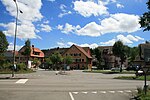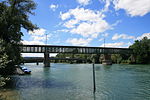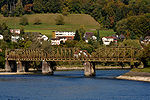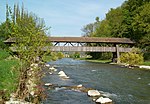Waldshut-Tiengen

Waldshut-Tiengen (German pronunciation: [ˌvalt͡sˈhuːt ˈtiːŋən]; Alemannic: Waldshuet-Düenge), commonly known as Waldshut, is a city in southwestern Baden-Württemberg right at the Swiss border. It is the district seat and at the same time the biggest city in Waldshut district and a "middle centre" in the area of the "high centre" Lörrach/Weil am Rhein to whose middle area most towns and communities in Waldshut district belong (with the exception of seven communities that belong to Bad Säckingen's area). There are furthermore complexities arising from cross-border traffic between this area and the Swiss cantons of Aargau, Schaffhausen and Zürich. This classification relates to Walter Christaller's Central Place Theory, however, and not to any official administrative scheme. The city, which was newly created in the framework of the 1975 municipal reform, at that time passed the 20,000 mark in population. City council then applied to have the city raised to Große Kreisstadt, which the government of Baden-Württemberg granted on 1 July 1976. Waldshut-Tiengen is also in an "administrative community" (Verwaltungsgemeinschaft) with the communities of Dogern, Lauchringen and Weilheim.
Excerpt from the Wikipedia article Waldshut-Tiengen (License: CC BY-SA 3.0, Authors, Images).Waldshut-Tiengen
Wallstraße, Waldshut-Tiengen
Geographical coordinates (GPS) Address Nearby Places Show on map
Geographical coordinates (GPS)
| Latitude | Longitude |
|---|---|
| N 47.623055555556 ° | E 8.2144444444444 ° |
Address
Wallstraße
Wallstraße
79761 Waldshut-Tiengen
Baden-Württemberg, Germany
Open on Google Maps










